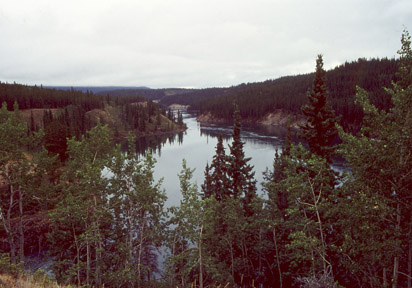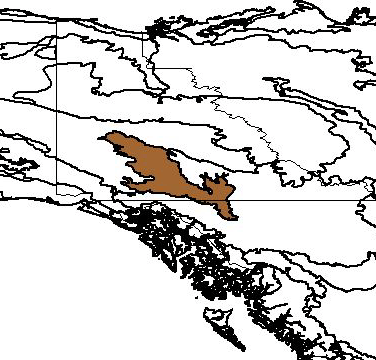
Yukon River near Whitehorse, Yukon (c) 2005 Scott and Ruth Bassett
Bioimages home (click on an image to enlarge)
view
this page in its intended navigation context
Yukon Interior dry forests
(WWF
ecoregion NA0617)

Yukon River near Whitehorse, Yukon
(c)
2005 Scott and
Ruth Bassett

Source of bioregions data:
Olson, D. M. and
E. Dinerstein. The Global 200: Priority ecoregions for global conservation. (PDF
file) Annals of the Missouri Botanical Garden 89:125-126.
Distinctiveness (1=highest,4=lowest): 4
(nationally important)
This ecoregion has an unusual association of plant communities because of the
juxtaposition of boreal forests with one of the most northerly grassland
communities. It supports large mammals as well as top-level predators.*
Conservation Status (1=most endangered, 5=most
intact): 3 (vulnerable)
About 75% of this ecoregion remains intact. Habitat loss has resulted from
forestry, mining, transportation corridors, and urbanization around Whitehorse.*
 Picea glauca (white spruce)
Picea glauca (white spruce) Picea mariana (black spruce)
Picea mariana (black spruce) | Pinus contorta | (lodgepole pine) |
Salix spp. (willows)
 | Abies lasiocarpa | (subalpine fir) |
Dryas hookeriana (mountain avens)
Associated habitats
River and forest, near Whitehorse, Yukon Territory


right: Yukon River
(c)
2005 Scott and
Ruth Bassett
hires
hires
Wet area, between Teslin Lake and Whitehorse, Yukon Territory

Picea mariana
(black spruce) (c)
2005 Scott and
Ruth Bassett
hires
* Ricketts, T.H., E. Dinerstein, D.M. Olson, C.J. Loucks, et al. (1999) Terrestrial Ecoregions of North America: A Conservation Assessment. World Wildlife Fund - United States and Canada. Island Press, Washington, D.C. pp. 357-358.
Except as noted, images copyright 2002-2005 Steve Baskauf - Terms of use